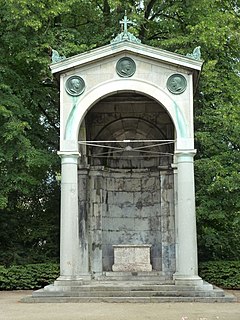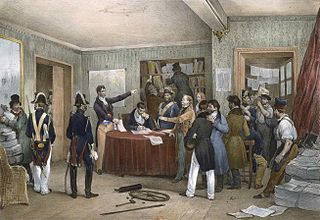 W
WThe Bourbon Restoration was the period of French history following the first fall of Napoleon in 3 May 1814 to the July Revolution of 26 July 1830, but interrupted by the Hundred Days War from 20 March 1815 to 8 July 1815. The brothers of the executed Louis XVI, namely Louis XVIII and Charles X, successively mounted the throne and instituted a conservative government aiming to restore the proprieties, if not all the institutions, of the Ancien Régime. Exiled supporters of the monarchy returned to France. They were nonetheless unable to reverse most of the changes made by the French Revolution and the reinstatement of slavery by Napoleon. Exhausted by decades of war, the nation experienced a period of internal and external peace, stable economic prosperity and the preliminaries of industrialization.
 W
WThe Chambre introuvable was the first Chamber of Deputies elected after the Second Bourbon Restoration in 1815. It was dominated by Ultra-royalists who completely refused to accept the results of the French Revolution. The name was coined by King Louis XVIII of France.
 W
WThe French Charter of 1814 was a constitutional text granted by King Louis XVIII of France shortly after the Bourbon Restoration, in form of royal charter. The Congress of Vienna demanded that Louis bring in a constitution of some form before he was restored. After refusing the proposed constitution, the Constitution sénatoriale, set forth on 6 April 1814 by the provisional government and the Sénat conservateur, Louis Stanislas Xavier, count of Provence, bestowed a different constitutional Charter, on 4 July 1814. With the Congress of Vienna's demands met, the count of Provence was officially crowned Louis XVIII, and the monarchy was restored.
 W
WThe Congress of Aix-la-Chapelle, held in the autumn of 1818, was a high-level diplomatic meeting of France and the four allied powers Britain, Austria, Prussia, and Russia which had defeated it in 1814. The purpose was to decide the withdrawal of the army of occupation from France and renegotiate the reparations it owed. It produced an amicable settlement, whereby France refinanced its reparations debt, and the Allies in a few weeks withdrew all of their troops.
 W
WThe First Restoration was a period in French history that saw the return of the Bourbon dynasty to the throne, between the abdication of Napoleon I in the spring of 1814 and the Hundred Days, in March 1815. The regime was born following the victory of the Sixth Coalition as part of the campaign of France, while the country was in conflict during the First Empire. While the Allied powers were divided over the person to be placed on the throne of France, a subtle game was established between the Bourbons in exile, the French institutions and the foreign powers, before the abdication of Napoleon I on the 6th of April opened the way to Louis XVIII, brother of Louis XVI, who returned to Paris at the end of the month and moved to the palace of the Tuileries.
 W
WThe Four Sergeants of La Rochelle were a group of French soldiers who plotted to overthrow the French monarchy of the Bourbon Restoration. Sergeants Bories, Pommier, Gobin and Raoulx were associates of the revolutionary Charbonnerie, a French secret society modelled after the Italian Carbonari. After being arrested for political conspiracy and membership of an outlawed organization, the four were guillotined in Paris on 21 September 1822.
 W
WThe Hundred Thousand Sons of Saint Louis was the popular name for a French army mobilized in 1823 by the Bourbon King of France, Louis XVIII, to help the Spanish Royalists restore King Ferdinand VII of Spain to the absolute power of which he had been deprived during the Liberal Triennium. Despite the name, the actual number of troops was around 60,000.
 W
WThe Journal des débats was a French newspaper, published between 1789 and 1944 that changed title several times. Created shortly after the first meeting of the Estates-General of 1789, it was, after the outbreak of the French Revolution, the exact record of the debates of the National Assembly, under the title Journal des Débats et des Décrets.
 W
WThe history of France from 1789 to 1914 extends from the French Revolution to World War I and includes:French Revolution (1789–1792) French First Republic (1792–1804) First French Empire (1804–1814/1815) Bourbon Restoration (1814/1815–1830) July Monarchy (1830–1848) Second Republic (1848–1852) Second Empire (1852–1870) Third Republic (1870-1940) Long Depression (1873–1890) Belle Époque (1871–1914)
 W
WThe Morea expedition is the name given to the land intervention of the French Army in the Peloponnese between 1828 and 1833, at the time of the Greek War of Independence, with the aim of expelling from the region the Ottoman-Egyptian occupation forces. It was also accompanied by a scientific expedition mandated by the French Academy.
 W
WThe National Guard is a French military, gendarmerie, and police reserve force, active in its current form since 2016 but originally founded in 1789 during the French Revolution.
 W
WLe National was a French daily founded in 1830 by Adolphe Thiers, Armand Carrel, François-Auguste Mignet and the librarian-editor Auguste Sautelet, as the mouthpiece of the liberal opposition to the Second Restoration.
 W
WThe Ominous Decade is a traditional term for the last ten years of the reign of King Ferdinand VII of Spain, dating from the abolition of the Spanish Constitution of 1812, on 1 October 1823, to his death on 29 September 1833.
 W
WThe Peerage of France was a hereditary distinction within the French nobility which appeared in 1180 in the Middle Ages, and only a small number of noble individuals were peers. It was abolished in 1789 during the French Revolution, but it reappeared in 1814 at the time of the Bourbon Restoration which followed the fall of the First French Empire, when the Chamber of Peers was given a constitutional function somewhat along British lines, which lasted until the Revolution of 1848. On 10 October 1831, by a vote of 324 against 26 of the Chamber of Deputies, hereditary peerages were abolished, but peerages for the life of the holder continued to exist until the chamber and rank were definitively abolished in 1848.
 W
WThe Second White Terror occurred in France in 1815, following the return of King Louis XVIII to power after the Hundred Days. Suspected sympathizers of the French Revolution, Republicans, Bonapartists and, to a minor degree, Protestants, suffered persecution. Several hundred were killed by angry mobs, or executed after a quick trial at a drumhead court-martial.
 W
WThe Trienio Liberal is a period of three years in the modern history of Spain between 1820 and 1823, when a liberal government ruled Spain after a military uprising in January 1820 by the lieutenant-colonel Rafael de Riego against the absolutist rule of Ferdinand VII.